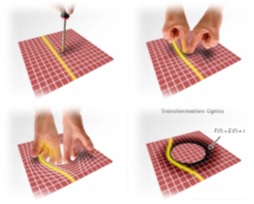Opening positions
in Mesoscopic Optics and Complex Media “Metamaterials with Flexural Waves”
 By replacing atoms with man-made elementary structures, new artificial materials may provide novel functionalities. These so-called metamaterials may bend waves in an unusual manner (“negative refraction”), hide objects (“cloaking”), focus light below the diffraction limit, …
By replacing atoms with man-made elementary structures, new artificial materials may provide novel functionalities. These so-called metamaterials may bend waves in an unusual manner (“negative refraction”), hide objects (“cloaking”), focus light below the diffraction limit, …
Flexural waves in thin plates are excellent candidates to test “crazy” ideas proposed by theoreticians. One such idea is transformational optics, a mathematical technique for designing such artificial materials. By using the appropriate coordinate transformation, media containing gradients in optical properties are designed to mimic curved geometries of space-time to hide objects. We want to investigate the broadband cloaking of objects using a number of active sources located outside the object. The challenge is to cancel the elastic field around the object without interfering with the incident field away from the target. Such a device should give the illusion that the object has disappeared or could show a different object instead (collaboration with Prof. M. Wegener, KIT, Germany).
Patrick SEBBAH, Director of Research at CNRS France, has recently moved to Israel and is now a new professor at the Physics Department, Bar Ilan University.
He offers 2 post Doc, 2 PhD programs, + projects for undergraduate students.
Includes: Metamaterials, Negative Refraction, Cloaking, Elastic Waves, Disordered Media, Active Media, Experimental Acoustic, Numerical Modeling. No strong background in fundamental Physics required.
For French students : grants available from the French Embassy. (deadline Jan. 31)



